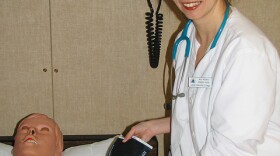Across the country, nurses are the most likely to be injured doing their jobs. For many nurses, back and joint pain is a fact of life but so is the risk of violence. According to the National Institute for Occupational Safety and Health, health care workers are at a 5 times greater risk for assault than people in other professions.
A hospital can be a stressful place and patients can be unpredictable.
"A patient tried to wrap my stethoscope around my neck... actually did wrap a stethoscope around my neck, but I managed to fight that off," recounted Kathy Day, a retired nurse who now works as a patient advocate. She’s had more than one violent encounter with a patient, and she’s not alone.
Statistics from the Bureau of Labor Statistics and a survey by the American Nurses Association show about 10 percent of nurses were assaulted physically in 2011, and half of survey respondents report verbal abuse or threats.
Unsurprisingly, the most dangerous units in the hospital are the Emergency Department and the psychiatric unit.
Jennifer Chesebro has been a nurse for 21 years. She now works as a Clinical Assistant Professor of Nursing at the College at Brockport. Her experiences with violence in the workplace have involved patients under the influence of drugs and alcohol. She remembers the time she first anyone administer Narcan, a medication that reverses the effects of narcotics.
"Someone had said stand back we're giving Narcan and I thought what do you mean? What do you want to stand back? Don't you want to be close to the patient to give them this care?" She remembers. "And when the patient woke up he just started punching he just started swinging. So it wasn't a huge injury but it was a good lesson. I never sat close to anyone that got Narcan again."
At Strong Memorial Hospital in Rochester, Chief Nursing Officer, Patricia Witzel explains nurses are warned to look out for certain patients.
"Patients that come in inebriated. Patients that come in with psychoses. patients that come in with dementia. They don't have a lot of controls and so again identifying those patients, getting to them to a less you know noisy less stimulation area is important," she said.
In high risk units, like Emergency, this hospital has four security guards at all times. At the beginning of a new shift, one of them walks through the unit with the lead nurse on duty to assess any potential risks.
According to Witzel, sometimes good practices such as keeping patients and their families updated about what’s happening with care can avoid problems before they begin.
"So they may be waiting three hours to hear about their loved one or their family member and they don't know what’s going on. Or the patient may feel that people aren't taking their concerns seriously and then the escalation starts."
Like many other hospitals, Strong trains the staff in de-escalation techniques and a staff safety committee looks into incidents when they occur.
Lisa Baum is an Occupational Health and Safety Representative for the New York State Nurses Association, the state’s labor union for the profession. She thinks hospitals should make sure security have training that reflects the needs of a health care setting, as well as use devices to protect nurses, like panic alarms, plexiglass barriers, and cameras. Overall, Baum wants to see a cultural change in the way a nurse’s job is viewed.
"And unfortunately violence is considered just part of the job and that there’s not much that can be done about it which is absolutely not true," Baum told WXXI.
That sense that it’s normal or “part of the job” is one reason nurses don’t report violent incidents. The U.S. Department of Health and Human Services estimates at least a third of these are never documented.






